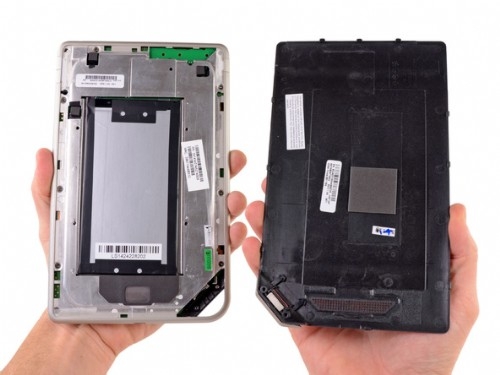Nook Tablet vs. Kindle Fire: The Differences Add Up
 We've just gotten a look Barnes and Noble's new 7-inch Nook Tablet, and surprise! It's very similar to Amazon's Kindle Fire. But the differences that do exist—in specs, price, and usability—are telling. Here's how it all breaks down.
We've just gotten a look Barnes and Noble's new 7-inch Nook Tablet, and surprise! It's very similar to Amazon's Kindle Fire. But the differences that do exist—in specs, price, and usability—are telling. Here's how it all breaks down.
Let's start with looks: the two both have 7-inch IPS displays, although the Nook Tablet is a little longer and lighter than the Kindle Fire. It also retains that odd carabiner-friendly rung in the lower right-hand corner, which, fine. The .5 ounce weight difference isn't much, but given that both tablets are already so much heavier than their E-ink ebook reader counterparts, every little bit may count over marathon reading sessions.
The wider gaps are on the inside; the Nook Tablet sports 16GB of storage and 1GB of RAM, compared to 8GB of storage compared 512MB of RAM on the Kindle Fire. And when you compare the two on specs alone, it's no small temptation to think that Amazon is outclassed. Amazon, though, holds most of your goodies in its cloud for you. That's potentially inconvenient for long, Wi-Fi-less trips, but the gap should be immaterial around the house, etc.
As for RAM, that can be a bit misleading as well; the iPad 2 and iPhone 4S seem to get along just fine with 512MB, while there are 1GB Android phones and tablets that can get burpy. What we can go on, though, is our hands-on impressions of the two tablets.In action today, the Nook Tablet's performance wasn't entirely promising. The custom built UI was noticeably sluggish, as was the web browser. On the plus side, the media apps ran smoothly. Our first look at the Kindle FIre, on the other hand, revealed shockingly fast and fluid performance even though it's got weaker specs on paper. The Amazon Kindle appears to be built on cheaper hardware but incorporates technologies like Amazon's Silk web browser to help the product run like a much stronger machine. We just don't know if Barnes and Noble found clever ways to optimize its device as well, although, Representatives did mention to us that the pre-loaded media apps ran beautifully because the Nook Tablet had been fine-tuned for flash video playback. We'll have to wait until the products are available for a full test to know for sure if these impressions are true.
And then there's battery life: Nook appears to have the edge, with a reported 11.5 hours of reading time and 9 hours of video, compared to 8 hours of reading and 7.5 hours of streaming playback on the Kindle Fire. Listed battery life and actual are often worlds apart, but one imagines that Amazon's not underselling itself by nearly three hours. Advantage Nook.
Besides the obvious considerations over speed and performance, the Nook Tablet/ Kindle Fire face off will likely come down to who can offer better services to customers. Both Amazon and Barnes and Noble offer extensive book ecosystems—fine—but what other media services will run on each device? We already know the Nook Tablet will come preloaded with apps for Netflix, Hulu, and Pandora. The purchase of a Kindle Fire comes with a free month of Amazon Prime, which means buyers will at the very least have access to Amazon Instant Video. They'll also be able to tap into the Amazon Appstore for additional Bezos-curated content.
The most noticeable difference between the two 7-inch tablets, though, is the price tag. At $250 the Nook Tablet is $50 more expensive than the $200 Kindle Fire. It seems as though Barnes and Noble expects the specs to justify the cost, but again: real world impressions indicate that they may not be all that far apart.
Without a full review, it's obviously too soon to tell which low-priced Android ebook reader will be crowned. But the little differences add up—and maybe not to fifty bucks.
안드로이드 운영체제를 쓴다는 이유로 갤럭시탭 같은 안드로이드 태블릿PC와 비교되고 있는 아마존 킨들파이어. 하지만 킨들파이어는 안드로이드를 커스텀함으로써 안드로이드 태블릿PC이길 스스로 거부한 면이 없지 않다. 오히려 자신들만의 세계를 구축하며 안드로이드가 가진 오픈소스의 이점만 가져오는 영민함을 보이고 있다.
반스앤노블의 누크 태블릿(Nook Tablet) 역시 얼마 전 모습을 드러냈다. 반스앤노블이 서점 체인에 뿌리를 두고 있다는 점을 생각하면 킨들파이어의 진정한 라이벌이라고 볼 수 있을 것이다. 아이픽스잇이 공개한 누크 태블릿 내부 모습을 소개해본다.
|
|
|
|
|
|
'관심사' 카테고리의 다른 글
| [김순덕 칼럼]한나라당이 더 살 수 있는가 (0) | 2011.12.04 |
|---|---|
| 삼성, 폴더형 듀얼코어 안드로이드폰 W999 중국시장에 발표 (0) | 2011.12.04 |
| 미 연방법원, 다스 BBK소송 취하 승인 (0) | 2011.12.03 |
| 말단 비서가 치밀하게… 단독 범행으로 보기 어려워 (0) | 2011.12.03 |
| 방통심의위 “신고 들어오면 나꼼수도 접속차단 가능” (0) | 2011.12.02 |






